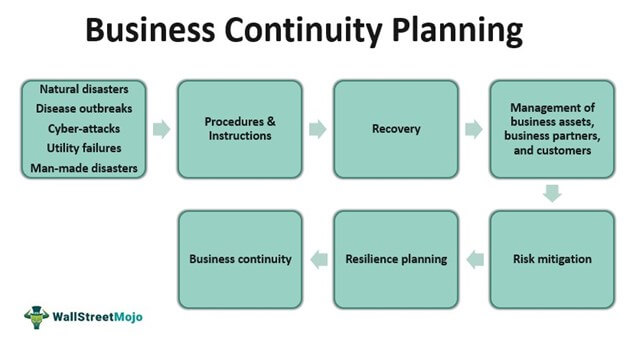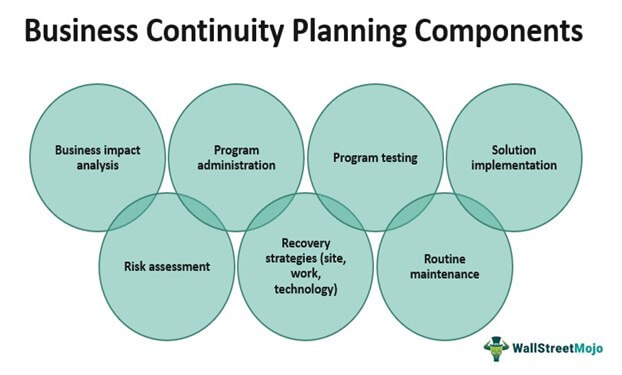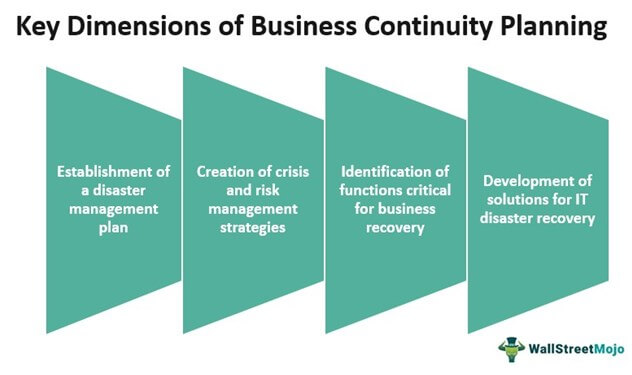And Business Continuing Planning What is the Primary Focus of the Scope
What Is Business Continuity Planning (BCP)?
Business continuity planning (BCP) is a set of procedures and instructions to restore critical business processes in the event of disasters. It is a document, which contains information about managing business assets, such as human resources and supplies and equipment, data backups, business partners, key personnel, etc.
Businesses of all sizes can suffer huge losses from disasters caused by fire, flood, disease outbreaks, and cyber-attacks. So, they require a strategy to identify potential risks, threats, or disruptions and implement a prevention and recovery system to continue operating as usual. It differs from a disaster recovery plan in that the latter focuses on restoring the IT infrastructure of a company after a calamity.
Table of contents
- What Is Business Continuity Planning (BCP)?
- How Does BCP Work?
- What Does Business Continuity Planning Include?
- Steps In Business Continuity Planning
- Example
- Frequently Asked Questions (FAQs)
- Recommended Articles

You are free to use this image on your website, templates, etc, Please provide us with an attribution link Article Link to be Hyperlinked
For eg:
Source: Business Continuity Planning (wallstreetmojo.com)
- A business continuity planning definition outlines procedures and strategies to prevent damage, resume operations, and recover during emergency or disaster events.
- It is a recovery approach for telecommunications, workstations, network security systems, data backup servers, and other vital resources for the smooth functioning of business operations.
- It also helps minimize the impact of the crisis on the business, irrespective of its size. Also, it ensures continuity of business and its ability to serve customers during a disaster.
- A well-documented business continuity strategy regarding the emergency response can help the staff understand the planning, risk assessment, and recovery measures.
How Does BCP Work?
Business continuity planning helps organizations minimize the impact of a natural or man-made disaster on their businesses. It outlines strategies to enact emergency management procedures, thereby avoiding service disruptions during disasters. In short, it is a subset of risk management to prevent loss of revenues and damage to reputation. Although insurances may cover losses, they will never compensate for clients who have switched to competitors.
Also known as business continuity and resiliency planning, it comprises various steps, including business impact analysis, recovery strategies, program testing and routine maintenance, solution implementation, and staff training. It enables companies to identify how threats and disruptions can affect their operations and develop an effective risk mitigation plan.

You are free to use this image on your website, templates, etc, Please provide us with an attribution link Article Link to be Hyperlinked
For eg:
Source: Business Continuity Planning (wallstreetmojo.com)
The plan includes measures to prevent supply chain and critical infrastructure (machinery and network security) interruptions. Thus, it ensures continuity in business and its ability to serve customers during a crisis.
A business continuity strategy must also focus on creating a trained emergency response team to manage the disruption. Also, it should be aware of the planning, risk assessment, and recovery measures to restore critical business functions. Key focus areas of a plan are:
- Establishment of a disaster management plan and program administration
- Creation of crisis and risk management strategies
- Identification of functions critical for business recovery
- Development of solutions for IT disaster recovery
What Does Business Continuity Planning Include?
A business continuity strategy ensures the organization's capability to perform business processes during emergencies or disasters.

You are free to use this image on your website, templates, etc, Please provide us with an attribution link Article Link to be Hyperlinked
For eg:
Source: Business Continuity Planning (wallstreetmojo.com)
The business continuity planning checklist must outline procedures for:
- Assigning recovery tasks to the planning committee
- Providing staff with complete documentation of steps and actions
- Conducting business impact analysis
- Communicating with customers, vendors, and third parties to check the company's quality of information and support
- Forming strategies and methods to continue providing the same services or products to customers after the disaster
- Working out the period needed to restore business processes and activities
- Supporting employees and planning on the number of employees to carry out internal and external processes
- Creating strategies on the manual processes, to be followed when technology is not available
- Providing remote workstations for staff when business locations are not available
Steps In Business Continuity Planning
The following steps help to implement a business continuity strategy:
- Identify key business processes and functions
- Execute planning and assignment of continuity teams and authorities
- Train the continuity team on emergency plans and strategies
- Perform business impact analysis and risk assessment
- Carry out processes with less resource availability
- Develop strategies for meeting the consumer demand
- Plan to hold reserve funds for emergencies An emergency fund is a source of money that you refrain from spending and store away safely to use in the time of need. Since it is readily available for withdrawal, savings invested in the emergency fund act as a savior during unforeseen circumstances. The emergencies can be a sudden job loss, emergency medical issues, or big losses in the financial market. read more
- Analyze systems and determine which critical functions to access during the event of an outage
- Establish clear channels for internal and external communication
- Review programs related to maintenance and quality control
- Develop remote working capabilities
- Create plans for improving and increasing self-service options for customers
- Create automation in the workflow for performing standard tasks
- Assign backup systems while implementing the planned tasks
Example
Let us look at a business continuity planning example to understand how it helps a business operate during a crisis. Colin and his business partner returned to their office after a long weekend. They found the building was full of water due to leakage from pipes reaching from the third-floor walls. On investigation, they discovered that the plumbing had frozen in the third-floor cafeteria, and pipes cracked out.
As a result, the office remained closed for repair operations for some days. Colin and his partner utilized the disaster management strategies already worked out in their BCP. As per their plans, they rented an office and some equipment for their business.
They continued to carry out their business operations Business operations refer to all those activities that the employees undertake within an organizational setup daily to produce goods and services for accomplishing the company's goals like profit generation. read more at a temporary location during the crisis. Another business unit in a different area also compensated their lost revenue. They also received their insurance claim An insurance claim refers to the demand by the policyholder to the insurance provider for compensating losses incurred due to an event covered by the policy. The company either validates or denies the claim based on their assessment and nature of the incurred losses. read more for the building damages, business interruptions, and extra expenses An expense is a cost incurred in completing any transaction by an organization, leading to either revenue generation creation of the asset, change in liability, or raising capital. read more for emergency management.
Frequently Asked Questions (FAQs)
What is a business continuity plan?
A business continuity plan is a document that outlines the techniques for implementing business strategies in a crisis. These plans aid in the restoration of business activities following unanticipated interruptions. A well-documented emergency response can help the staff to understand methods involved in the planning, risk assessment, and recovery steps.
What is the business continuity process in the supply chain?
A supply chain includes third-party suppliers, business partners, service providers, and customers. Planning the business continuity processes for the risk management in the supply chain involves the contribution of these members in planning, monitoring, and executing the strategy.
What is a business continuity plan template?
A business continuity planning template is often used by business continuity managers and IT divisions for documenting emergency response strategies. It contains methods for continuous business functions and operations during emergencies, such as catastrophes, extreme weather conditions, power outages, cyber-attacks, etc.
Recommended Articles
This has been a guide to Business Continuity Planning (BCP). Here we discuss how does it work, along with the steps involved and examples. You can learn more from the following articles –
- Risk Manager
- Black Swan Event
- Financial Guarantee
fullerposinion2001.blogspot.com
Source: https://www.wallstreetmojo.com/business-continuity-planning/
0 Response to "And Business Continuing Planning What is the Primary Focus of the Scope"
Enregistrer un commentaire